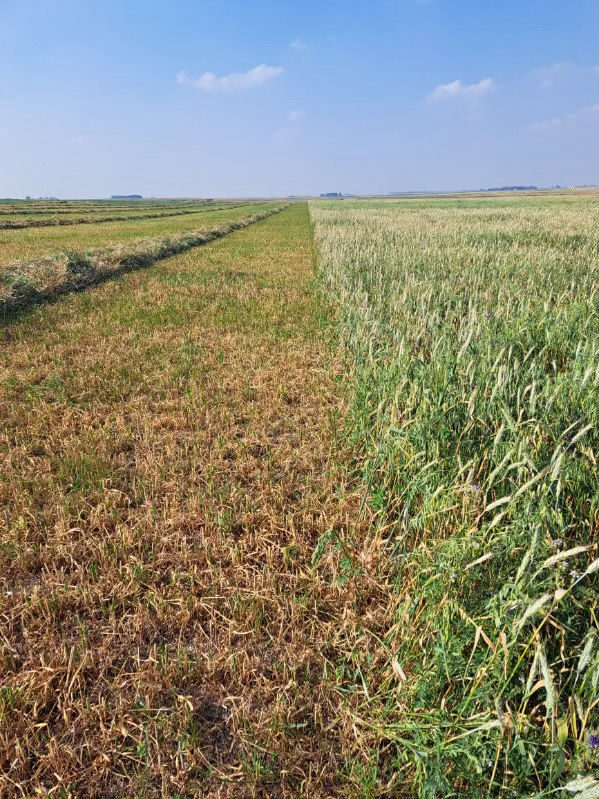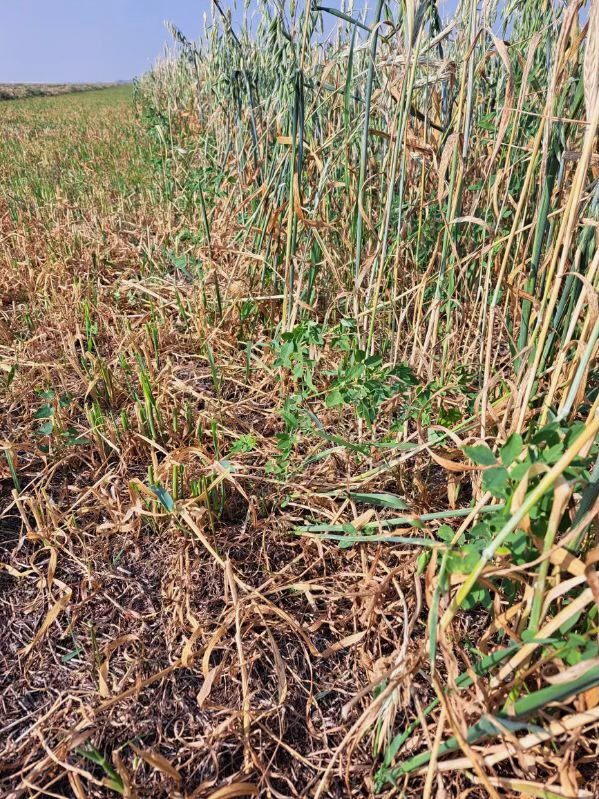BMP Bingo: When One Paddock Does It All
- communications8404
- Nov 5, 2024
- 4 min read
Daryl Chubb & Karen Schiml’s Living Lab on the Prairies
Before “living labs” became part of the regenerative agriculture conversation, Daryl Chubb and Karen Schiml were already living the concept—quite literally—on their farm. Nestled in southern Alberta, their quarter section is divided into 10-acre paddocks with a central alley and managed using adaptive multi-paddock (AMP) grazing. But it's not just the infrastructure that sets their place apart—it's the mindset.
Daryl is an independent ag consultant. Karen is a beef nutritionist. When they’re not farming and ranching, they’re deep into professional roles that inform—and are informed by—their land-based experiments. Karen’s deep care for cattle and Daryl’s unrelenting curiosity for “what might work better” has created a farm culture centered on innovation, risk-taking, and relentless learning.
And this year, one paddock in particular captured the full attention of the Regenerative Alberta Living Lab (RA-LL) team.

A Paddock That Stopped Us in Our Tracks
With a project mandate to push the boundaries of regenerative agriculture and soil health, we’re used to seeing creative approaches. But even by our standards, this paddock hit a new level. So many best management practices (BMPs) were layered in that we struggled to categorize it.
The result? A BMP blackout in what we affectionately call “BMP Bingo.”
Let’s walk through what happened.
From Sod to Soil Health Showcase
Step One: Intentional Grazing and Transition
The season began with a heavy graze on the perennials in the paddock. Afterward, rather than tilling, the team applied glyphosate to terminate the stand—then direct-seeded into sod. That means zero tillage. Right away, this ticked off major soil health boxes: minimal disturbance, soil armor, and living roots.
Step Two: A Diverse Seeding Mix
Into that sod, they seeded spring triticale, oats, sweet clover, peas, and winter triticale—a mix that ensures ongoing root growth and biodiversity throughout the season. The staggered maturity of the triticale types meant the field stayed green and growing when harvested for green feed.
Step Three: Supporting the Biology
The seed wasn’t left on its own. It was treated with phosphorus, worm extract, micronutrients, and humics, and they floated 65 lbs of nitrogen and 12 lbs of ammonium sulfate. These additions aimed to stimulate early establishment while reducing reliance on synthetic fertilizers through strategic biological inputs.
Step Four: Grazing as a Tool for Establishment
Grazing wasn’t just an endpoint—it was a tool for success. Livestock helped manage the initial forage, cycle nutrients, and contribute to plant establishment in a way no machine could.

BMP Bingo: A Full House
Here’s what they stacked into one system:
✅ Perennial forages in annual crop rotations
✅ Annuals seeded into perennial stands
✅ Cocktail cover crops (for livestock feed)
✅ Intercropping/companion cropping
✅ Relay cropping & seeding green
✅ Application of biological amendments
✅ Livestock and annual crop integration
✅ Tame forage rejuvenation
✅ Extended grazing potential
✅ No-till seeding into sod
✅ Increased legumes in crop rotations
Every soil health principle was hit:
Reduce disturbance – zero tillage
Keep soil covered – dense seeding for ground armor
Maintain living roots – staggered species for continual green growth
Plant diversity – mix of cereals, legumes, and cover crops
Livestock integration – grazing before and after
Input reduction – targeted biologicals and reduced synthetics

Unexpected Revival: What Brought the Alfalfa Back?
One of the most surprising outcomes? The resurgence of alfalfa in the paddock.
While this wasn’t a planned goal, it’s a great example of how regenerative systems often deliver more than expected. The mix of deep-rooted plants, the influx of biological inputs, and the dynamic grazing pressure appear to have re-energized dormant alfalfa plants that had been lagging in previous seasons.
What could explain this? Here's a hypothesis we're watching closely.
Alfalfa fixes nitrogen thanks to Rhizobium bacteria living in nodules on its roots. These beneficial microbes can sometimes be suppressed by bacteriophages—viruses that attack bacteria. While this is still an emerging field, researchers are exploring whether shifts in soil carbon-to-nitrogen (C:N) ratios, especially through diverse cover crops and enhanced soil carbon, could improve the resilience of nitrogen-fixing bacteria.
We’re not drawing hard conclusions yet—but we’re definitely intrigued. It’s yet another sign that soil health is as much about biological relationships as it is about physical and chemical ones.
Soil Data on the Horizon: Learning by Doing
The RA-LL team is now tracking key soil health indicators in this paddock, including:
Soil organic carbon
Aggregate stability
Available nutrients and efficiency
Microbial community structure and function

This is more than an experiment—it’s a roadmap.
By layering BMPs and observing both expected and unexpected results, Daryl and Karen have helped us push the conversation from "what works" to why it works, and for whom. When producer-led innovation is paired with research-grade monitoring and mapping, the outcomes aren’t just anecdotal—they’re actionable.
This kind of experimentation is what the RA-LL project is all about: a place where innovation is measured, shared, and used to inspire others.
Whether you’re just dipping your toe into regenerative practices or you’ve been stacking BMPs for years, we hope this story sparks ideas—and maybe even encourages you to try something bold.
Inspired by this approach? Got a paddock you’d like to experiment with?Let’s talk. Because the next innovation in soil health might just start in your field.
Comments